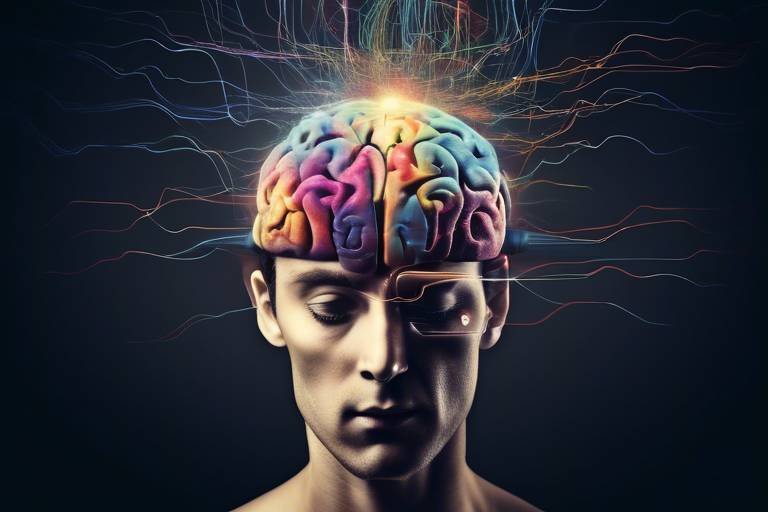Do Other Animals Experience Consciousness?
Have you ever looked into the eyes of a pet and wondered what they are thinking? Or perhaps you've observed a dolphin leaping joyfully through the waves and pondered whether it feels happiness like we do. The question of whether non-human animals experience consciousness is not just a philosophical musing; it's a profound inquiry that challenges our understanding of life itself. Consciousness, in its simplest form, refers to the awareness of oneself and the environment. But how do we define it in the context of non-human species? This article aims to unravel the complexities of animal consciousness, exploring scientific insights, philosophical debates, and compelling examples from the animal kingdom.
From the bustling jungles to the depths of the oceans, animals exhibit behaviors that suggest a rich inner life. Imagine a chimpanzee using tools to extract termites from a mound or an elephant mourning the loss of a companion. These instances raise an important question: Are these behaviors mere instincts, or do they indicate a deeper level of awareness? As we delve into this topic, we will explore various scientific perspectives, philosophical arguments, and real-world examples that illuminate the fascinating world of animal consciousness.
Understanding consciousness is not just an academic exercise; it has profound implications for how we treat other beings. If animals possess some form of consciousness, it challenges us to reconsider our ethical responsibilities toward them. As we journey through this exploration, we will uncover the layers of complexity surrounding this topic, engaging with both the science and the philosophy that underpin our understanding of consciousness in the animal kingdom.
Before we dive deeper, it's crucial to establish what we mean by consciousness. Various definitions exist, often shaped by different fields of study. In psychology, consciousness is typically viewed as the state of being aware of and able to think about one's own existence, thoughts, and surroundings. Neuroscience adds another layer, suggesting that consciousness arises from specific brain activities and interactions. Philosophers, on the other hand, may argue that consciousness encompasses subjective experiences—those unique feelings and perceptions that are inherently personal.
To grasp the concept of consciousness in animals, we need to consider several factors:
- Self-awareness: The ability to recognize oneself as an individual separate from the environment.
- Emotional experience: The capacity to feel emotions such as joy, sadness, or empathy.
- Problem-solving capabilities: The ability to navigate challenges and adapt to new situations.
With these definitions in mind, we can explore the scientific perspectives that seek to understand whether animals possess consciousness.
Scientific research into animal consciousness has gained momentum in recent years, with studies focusing on various species' cognitive abilities. Neurological studies have revealed fascinating insights into how different brains function and how they might relate to consciousness. For instance, research has shown that certain animals, like dolphins and elephants, have complex brain structures that are surprisingly similar to those of humans.
One groundbreaking study involved the mirror test, where animals are placed in front of a mirror to see if they can recognize themselves. Species like great apes, elephants, and even some birds have passed this test, suggesting a level of self-awareness that was once thought to be unique to humans. Such findings challenge the notion that consciousness is a human-only trait and invite us to rethink our relationship with other species.
Philosophers have long debated the nature of consciousness, often questioning whether animals can experience subjective awareness. One significant argument is the concept of sentience, which refers to the capacity to feel and perceive. If we accept that many animals can feel pain and joy, does it not follow that they possess some form of consciousness? This line of reasoning raises ethical implications about how we treat animals in various contexts, from farming to entertainment.
Additionally, the question of whether consciousness is a binary trait or exists on a spectrum is worth considering. Could it be that some animals experience consciousness differently than humans do, perhaps in a more instinctual or primal way? These philosophical discussions deepen our understanding of consciousness and challenge us to reconsider our assumptions.
Observing animal behavior offers a wealth of evidence that suggests many species exhibit signs of consciousness. Take, for example, the intricate social structures of wolves or the complex communication systems of dolphins. These behaviors indicate not just instinct but also cognitive processes that require awareness and understanding of social dynamics.
Moreover, animals demonstrate problem-solving skills that further hint at their cognitive abilities. For instance, crows are known for their remarkable intelligence, often using tools to obtain food. Such behaviors highlight an awareness of their environment and the ability to manipulate it for their benefit, suggesting a level of consciousness that merits our attention.
Comparative studies among species can reveal fascinating similarities and differences in consciousness. Research comparing human consciousness with that of primates, cetaceans, and other animals has yielded intriguing insights. For instance, studies have shown that both humans and dolphins possess advanced communication skills, hinting at a shared cognitive complexity.
| Species | Key Cognitive Abilities | Evidence of Consciousness |
|---|---|---|
| Great Apes | Tool use, social learning | Mirror test, emotional expressions |
| Dolphins | Complex communication, problem-solving | Self-recognition, social bonding |
| Elephants | Memory, empathy | Mourning behaviors, cooperation |
If we accept that animals possess some form of consciousness, it compels us to confront significant ethical questions. What moral responsibilities do we have toward conscious beings? Should we rethink practices such as factory farming, animal testing, and habitat destruction? These questions are not just academic; they have real-world implications that affect millions of animals and the ecosystems they inhabit.
Numerous case studies highlight the remarkable intelligence and emotional depth of various species. Elephants, for instance, have shown behaviors indicative of grief, such as mourning their dead. Dolphins have been observed engaging in playful interactions that suggest a sense of joy. Great apes display empathy and social bonding, further supporting the idea that they experience consciousness in ways that resonate with human emotions.
The field of animal consciousness research is evolving, with new methodologies and technologies emerging. Future studies may focus on neuroimaging techniques to explore brain activity in various species, providing deeper insights into the nature of consciousness. Additionally, interdisciplinary approaches combining neuroscience, behavioral science, and philosophy may pave the way for a more comprehensive understanding of consciousness across species.
- Do all animals experience consciousness? - While many animals show signs of consciousness, the extent and nature of that consciousness can vary widely among species.
- How do scientists measure animal consciousness? - Researchers use various methods, including behavioral tests, neurological studies, and observational research, to assess cognitive abilities and self-awareness in animals.
- What are the ethical implications of recognizing animal consciousness? - Recognizing animal consciousness raises questions about our treatment of animals and our responsibilities toward their welfare and rights.

The Definition of Consciousness
Understanding consciousness is crucial when we dive into the fascinating world of animal awareness. At its core, consciousness can be described as the state of being aware of and able to think about one's own existence, thoughts, and surroundings. But here's the kicker—consciousness isn't a one-size-fits-all concept. Different theories attempt to capture its essence, leading to a rich tapestry of interpretations that can vary significantly across species.
To break it down, let’s consider a few definitions that have emerged in scientific and philosophical circles:
- Phenomenal Consciousness: This refers to the subjective experience of being aware, like the vivid colors of a sunset or the taste of your favorite dessert.
- Access Consciousness: This involves the ability to use information in reasoning and behavior, allowing an individual to respond to their environment.
- Self-Awareness: This is a higher level of consciousness where an individual recognizes themselves as distinct from others, often tested through the mirror test.
When we talk about measuring consciousness, things get even trickier. Scientists often rely on a mix of behavioral observations and neurological assessments to gauge the level of consciousness in different species. For instance, researchers might look at how an animal reacts to complex problems or how they interact with their peers. These behaviors can serve as indicators of their cognitive capabilities and, by extension, their consciousness.
One of the most compelling aspects of consciousness is its spectrum. Think of it like a rainbow; some animals may display a rich array of conscious experiences, while others might show only the faintest hints. For example, while humans exhibit complex emotional and cognitive processing, some studies suggest that animals like dolphins and great apes also demonstrate remarkable levels of awareness, problem-solving skills, and emotional depth.
In conclusion, defining consciousness is not just an academic exercise; it's a journey into understanding what it means to be alive and aware. As we continue to explore this concept, we must remain open to the possibility that consciousness exists on a spectrum, one that encompasses a broad range of experiences across the animal kingdom. This inquiry not only fuels our curiosity but also challenges us to reconsider our relationship with other sentient beings.

Scientific Perspectives on Animal Consciousness
When we dive into the realm of animal consciousness, it’s essential to grasp the scientific underpinnings that shape our understanding. Consciousness isn't just a human trait; it’s a complex phenomenon observed in various forms across the animal kingdom. Researchers have employed different methodologies to study this intriguing topic, ranging from neurological examinations to behavioral analyses. One of the most compelling approaches has been the use of neuroimaging techniques, which allow scientists to visualize brain activity in different species.
For instance, studies utilizing functional magnetic resonance imaging (fMRI) have shown that certain animals, such as primates and dolphins, exhibit brain patterns similar to those of humans when engaging in tasks requiring problem-solving and social interaction. These findings suggest that their cognitive processes might mirror our own to some degree, hinting at a shared experience of consciousness. But how do we define consciousness in a way that encompasses these diverse species?
Traditionally, consciousness has been associated with self-awareness, the ability to reflect on one’s own thoughts, and the capability to experience emotions. The famous mirror test, introduced by psychologist Gordon Gallup Jr. in 1970, is often used as a benchmark for self-awareness. In this test, a mark is placed on an animal in a location it cannot see without a mirror. If the animal uses the mirror to investigate and possibly remove the mark, it suggests a level of self-awareness. Species such as elephants, great apes, and even some birds have passed this test, raising questions about their conscious experience.
Moreover, neurological studies have revealed that animals possess complex brain structures. For example, the neocortex, which is crucial for higher-order brain functions, is not exclusive to humans. Many mammals, particularly primates and cetaceans, have similarly developed neocortexes. This anatomical similarity begs the question: if the brain structure is there, does it follow that consciousness exists?
In addition to neuroanatomy, researchers have also examined the behavioral aspects of consciousness. Observations of social interactions among elephants, known for their deep emotional bonds, reveal behaviors that suggest empathy and grief. When a member of their herd passes away, elephants have been seen mourning, touching the bones with their trunks, and even standing vigil over the body. Such behaviors indicate a level of emotional awareness that challenges the traditional view of consciousness as a uniquely human trait.
To further illustrate the scientific perspectives on animal consciousness, consider the following table that summarizes key findings from notable studies:
| Animal Species | Study Focus | Key Findings |
|---|---|---|
| Great Apes | Mirror Test | Demonstrated self-recognition and problem-solving abilities. |
| Dolphins | Neuroimaging | Showed complex brain activity during social interactions. |
| Elephants | Behavioral Studies | Exhibited mourning behaviors and emotional depth. |
| Crows | Cognitive Tasks | Utilized tools and demonstrated planning abilities. |
In conclusion, the scientific perspectives on animal consciousness are as varied as the species themselves. With ongoing research and advancements in technology, we are continually uncovering layers of complexity in the minds of non-human animals. The more we learn, the more we realize that consciousness may not be a binary trait but rather a spectrum that spans across different forms of life. As we continue to explore this fascinating field, we must remain open to the possibility that consciousness is a shared experience among many living beings, each with its own unique expression.
- What is consciousness? Consciousness refers to the state of being aware of and able to think about one's own existence, thoughts, and surroundings.
- Do animals have consciousness? Many scientists believe that various animal species exhibit signs of consciousness, particularly those with complex brain structures.
- How do we measure consciousness in animals? Researchers use methods like neuroimaging, behavioral tests (such as the mirror test), and observational studies to assess consciousness in animals.
- Why is understanding animal consciousness important? Understanding animal consciousness can influence our ethical treatment of animals and shape policies regarding animal rights and welfare.

Philosophical Arguments
When we dive into the realm of consciousness, we can't ignore the rich tapestry of philosophical arguments that have emerged over the centuries. These discussions often raise profound questions about what it means to be conscious. Are we merely biological machines, or is there something more to our existence? And if we ponder this for ourselves, shouldn't we extend the same consideration to our fellow non-human companions? The philosophical debate surrounding animal consciousness is not just academic; it has real-world implications for how we treat animals.
One of the most compelling arguments comes from the concept of subjective experience. This idea suggests that consciousness isn't just about having a brain or the ability to respond to stimuli; it's about having an inner life. Think about it: when you feel joy, sadness, or even boredom, those feelings create a unique tapestry of experiences that shape your understanding of the world. Philosophers like Thomas Nagel have famously asked, "What is it like to be a bat?" This question challenges us to consider the subjective experiences of other beings, pushing us to acknowledge that animals may perceive their world in ways we cannot even begin to imagine.
Moreover, the argument from analogy plays a significant role in this discussion. If we observe behaviors in animals that are similar to those exhibited by humans, can we not infer that they might have similar conscious experiences? For instance, when a dog wags its tail and jumps excitedly upon seeing its owner, it seems to express joy. If we accept that our own joy is a conscious experience, it stands to reason that the dog's behavior might also stem from a conscious state. This analogy can be extended across various species, challenging us to rethink our assumptions about consciousness.
In contrast, some philosophers argue from a more skeptical standpoint, suggesting that attributing consciousness to animals is anthropocentric, or human-centered. They caution against projecting our own experiences onto other species, emphasizing that just because an animal behaves in a way that resembles human emotion, it doesn't necessarily mean it experiences those emotions in the same way. This perspective raises important questions about the limits of our understanding and the dangers of anthropomorphism.
To further enrich this discourse, we can look at the theory of mind, which refers to the ability to attribute mental states—beliefs, intents, desires—to oneself and others. This cognitive skill is often considered a hallmark of consciousness. Studies have shown that certain animals, such as great apes and dolphins, exhibit behaviors suggesting they possess a theory of mind. For example, a chimpanzee might deceive another by hiding food, indicating an understanding that the other chimp has a different perspective. Such behaviors challenge the notion that consciousness is a uniquely human trait and invite us to consider the mental lives of other species.
Ultimately, these philosophical arguments weave a complex narrative about consciousness. They compel us to confront our biases and assumptions while pushing the boundaries of our understanding. As we investigate the consciousness of non-human animals, we must grapple with our ethical responsibilities towards them. If we accept that animals experience consciousness, we are faced with a moral imperative to treat them with respect and compassion.
- What is consciousness? Consciousness refers to the state of being aware of and able to think about one's own existence, thoughts, and surroundings.
- Do all animals have consciousness? While not all animals may possess consciousness in the same way humans do, many studies suggest that various species exhibit signs of awareness and complex emotional responses.
- Why is it important to study animal consciousness? Understanding animal consciousness can significantly impact how we treat animals, influencing ethical considerations regarding animal rights and welfare.
- What are some examples of animals that show signs of consciousness? Elephants, dolphins, and great apes are frequently cited examples due to their complex behaviors and emotional depth.

Animal Behavior and Cognition
When we think about animal behavior, it often conjures images of pets playing fetch or birds singing in the morning. But there's so much more beneath the surface! Animals exhibit a wide range of behaviors that suggest a level of cognition and awareness previously thought to be exclusive to humans. For instance, have you ever seen a dog solve a puzzle to get to its favorite treat? This isn’t just instinct; it’s a demonstration of problem-solving skills and a form of understanding their environment.
One fascinating aspect of animal cognition is the ability to use tools. Take the New Caledonian crow, for example. These birds have been observed crafting tools from leaves and twigs to extract insects from hard-to-reach places. This behavior not only shows their ability to manipulate objects but also indicates a level of foresight and planning. It’s almost as if they’re saying, “I need this tool to achieve my goal,” which is a thought process we often associate with human intelligence.
Moreover, emotional responses in animals add another layer to our understanding of their consciousness. Elephants, for instance, are known for their profound emotional depth. They mourn their dead, showing behaviors such as touching the bones of deceased companions and exhibiting signs of distress. This leads us to ponder—are they simply reacting to stimuli, or is there a deeper understanding of loss? The way animals express emotions can be quite similar to humans, suggesting a complex inner life.
In addition to emotional intelligence, animals demonstrate remarkable social behaviors. Consider the intricate social structures of dolphins. They communicate with each other using a variety of clicks and whistles, and they can even recognize themselves in mirrors, a sign of self-awareness. This level of social interaction and communication is not just instinctual; it implies a conscious understanding of their place within a social group.
To further illustrate the connection between behavior and cognition, researchers have conducted numerous studies observing how animals learn from one another. For example, in a study involving chimpanzees, it was found that they could learn new skills by watching their peers. This ability to learn through observation suggests that these animals possess a level of awareness and understanding about their environment that goes beyond mere survival instincts.
As we delve deeper into the study of animal cognition, we find that the behaviors exhibited by various species can often reflect a rich tapestry of consciousness. Whether it’s through problem-solving, emotional depth, or social interactions, the evidence increasingly points to the idea that animals are not just mindless beings reacting to their surroundings; they are conscious creatures with their own unique perspectives on the world.
In conclusion, the study of animal behavior and cognition opens up a fascinating dialogue about consciousness. It challenges us to reconsider our assumptions about what it means to be aware and sentient. As we observe these remarkable creatures, we may find that the line separating human and animal consciousness is not as clear-cut as we once thought.
- Do animals have emotions? Yes, many studies suggest that animals experience a range of emotions similar to humans, including joy, grief, and empathy.
- Can animals learn from each other? Absolutely! Many species, including primates and birds, have demonstrated the ability to learn new skills by observing their peers.
- What is tool use in animals? Tool use is when animals manipulate objects to achieve a goal, such as using sticks to extract insects or stones to crack open shells.
- Are dolphins self-aware? Yes, dolphins have shown self-recognition in mirror tests, indicating a level of self-awareness.

Comparative Studies of Consciousness
The quest to understand consciousness is not just a human endeavor; it extends to our understanding of other species as well. Comparative studies of consciousness allow researchers to delve into the minds of various animals, exploring how they perceive the world and whether they possess a sense of self. These studies often focus on primates, cetaceans, and even birds, revealing fascinating insights into their cognitive abilities and emotional depth.
One of the most intriguing aspects of these comparative studies is the exploration of self-awareness. For instance, the mirror test, which assesses an animal's ability to recognize itself in a mirror, has been a significant indicator of consciousness. Animals like dolphins, elephants, and some primates have passed this test, suggesting they have a level of self-recognition that many other species lack. This raises the question: if these animals can recognize themselves, what does that say about their inner experiences?
Moreover, researchers have conducted studies that compare cognitive abilities across species. For example, studies have shown that certain birds, like the New Caledonian crow, exhibit problem-solving skills comparable to those of primates. These birds can use tools, plan for the future, and even solve complex puzzles, demonstrating a level of intelligence that challenges our traditional views of consciousness. Such findings make us reconsider the definition of consciousness itself and whether it is a uniquely human trait.
In addition to cognitive skills, emotional responses in animals also provide critical insights into their consciousness. Comparative studies have shown that elephants exhibit behaviors indicative of empathy, such as comforting distressed companions. This emotional intelligence suggests that their consciousness may be more complex than previously thought. Similarly, studies on cetaceans, particularly dolphins, reveal that these marine mammals engage in cooperative hunting and display intricate social bonds, hinting at a rich inner life.
| Species | Self-Awareness | Cognitive Abilities | Emotional Intelligence |
|---|---|---|---|
| Dolphins | Yes | Advanced problem-solving | Empathy and social bonding |
| Elephants | Yes | Tool use and memory | Grief and altruism |
| Great Apes | Yes | Complex tool use | Emotional depth |
| New Caledonian Crow | No | Advanced tool-making | Limited emotional expression |
These comparative studies not only highlight the similarities between human and non-human consciousness but also challenge the notion of a strict hierarchy of intelligence. They compel us to acknowledge that consciousness may exist on a spectrum, with various species exhibiting different facets of awareness. As we continue to explore these differences and similarities, one thing becomes clear: the animal kingdom is far more complex than we ever imagined.
As we look to the future, the field of comparative consciousness studies is ripe for exploration. New technologies, such as neuroimaging, offer exciting possibilities for understanding how different brains process information and experience the world. By continuing to investigate these questions, we can deepen our appreciation for the rich tapestry of life on Earth and the consciousness that permeates it.
- What is the mirror test, and what does it measure?
The mirror test is an experiment used to determine whether an animal can recognize itself in a mirror, indicating self-awareness. - Do all animals possess consciousness?
Consciousness likely exists on a spectrum, with varying degrees of awareness and cognitive abilities across different species. - How do researchers study animal emotions?
Researchers observe behaviors, social interactions, and physiological responses to determine emotional states in animals.

Ethical Implications of Animal Consciousness
The question of whether non-human animals experience consciousness is not just a scientific or philosophical inquiry; it carries profound ethical implications that challenge our relationship with the animal kingdom. If animals possess consciousness, it suggests they have the capacity for subjective experiences, feelings, and thoughts, similar to humans. This realization compels us to rethink how we treat animals in various contexts, from farming and entertainment to scientific research.
For instance, consider the implications for animal agriculture. If we acknowledge that animals experience suffering and joy, we must confront the ethics of factory farming, where animals live in cramped conditions and are often subjected to painful procedures. The idea that these creatures can feel fear or distress raises serious moral questions about our dietary choices and the systems we support. Are we willing to accept the suffering of conscious beings for the sake of convenience or profit?
Moreover, the ethical considerations extend beyond just consumption. In the realm of animal testing, acknowledging consciousness would demand stricter regulations and perhaps a reevaluation of the necessity of using animals in experiments. If an animal can experience pain, should we not prioritize alternatives that do not involve sentient beings? This leads to a broader discussion about animal rights and welfare, pushing society to advocate for humane treatment and legal protections for animals.
Furthermore, the implications of animal consciousness also touch on conservation efforts. Recognizing that animals possess a form of awareness can influence how we approach species preservation. It encourages a more empathetic perspective where we see animals not just as resources to be exploited but as beings with intrinsic value. This shift in viewpoint can foster greater support for conservation initiatives aimed at protecting habitats and ensuring the survival of species that might otherwise be neglected.
In light of these considerations, we can identify several key ethical responsibilities that arise from the acknowledgment of animal consciousness:
- Promoting Welfare: Ensuring that animals are treated humanely and their needs are met.
- Reducing Suffering: Actively working to minimize pain and distress in all interactions with animals.
- Advocating for Rights: Supporting legislation that protects animals and their habitats.
- Encouraging Alternatives: Developing and promoting non-animal testing methods in research.
Ultimately, the ethical implications of animal consciousness challenge us to reflect on our values and behaviors. They invite a deeper connection with the animal world, urging us to recognize the shared experiences of all living beings. As we advance in our understanding of consciousness, we must also advance in our compassion and responsibility towards those who share our planet.
1. What is animal consciousness?
Animal consciousness refers to the awareness and subjective experience that non-human animals may possess, which includes their ability to feel emotions, perceive their environment, and engage in complex behaviors.
2. How do scientists study animal consciousness?
Scientists study animal consciousness through various methods, including behavioral observations, neurological studies, and comparative analyses with human cognitive processes.
3. What are the ethical implications of recognizing animal consciousness?
Recognizing animal consciousness raises ethical questions regarding animal welfare, rights, and our responsibilities towards them in contexts such as agriculture, research, and conservation.
4. Can all animals be considered conscious?
While many animals exhibit signs of consciousness, the degree and nature of consciousness may vary across species. Ongoing research continues to explore these differences.

Case Studies in Animal Consciousness
The exploration of animal consciousness is not just a theoretical endeavor; it is enriched by real-world observations and case studies that reveal the profound cognitive and emotional capabilities of various species. One of the most compelling examples comes from the world of elephants. These magnificent creatures exhibit behaviors that suggest a deep level of awareness and emotional intelligence. For instance, elephants have been observed mourning their dead, a behavior indicating a complex understanding of loss. They will often return to the bones of deceased elephants, touching them gently with their trunks and standing quietly in a state of apparent grief. This suggests not only a recognition of their companions but also an emotional response that resonates with human experiences of loss.
Another fascinating case study involves dolphins, known for their sophisticated social structures and communication skills. Research has shown that dolphins can recognize themselves in mirrors, a trait often associated with self-awareness. In one study, dolphins were trained to perform tasks in front of mirrors and displayed behaviors indicating they understood that the reflection was themselves and not another dolphin. This level of self-recognition is a significant indicator of consciousness, as it implies an understanding of one’s own identity and existence.
Great apes, such as chimpanzees and orangutans, also provide compelling evidence of consciousness. In various experiments, these primates have demonstrated the ability to use tools, solve complex problems, and engage in social learning. For example, chimpanzees have been observed using sticks to extract termites from mounds, showcasing not only intelligence but also the ability to plan and execute a task. Furthermore, studies have shown that they can understand the perspectives of others, which is a crucial aspect of consciousness. They can anticipate the actions of their peers based on previous interactions, suggesting a level of cognitive empathy.
To illustrate these findings, consider the following table summarizing key behaviors associated with consciousness in different animal species:
| Animal Species | Behaviors Indicating Consciousness |
|---|---|
| Elephants | Mourning behaviors, recognizing deceased companions, displaying empathy |
| Dolphins | Self-recognition in mirrors, complex communication, social learning |
| Great Apes | Tool use, problem-solving, understanding others' perspectives |
These case studies not only highlight the cognitive abilities of these animals but also challenge our perceptions of consciousness. They prompt us to reconsider how we define consciousness and who we recognize as sentient beings. As we delve deeper into the lives of these creatures, we begin to see reflections of our own experiences, emotions, and social connections, blurring the lines between human and animal consciousness.
In addition to these remarkable examples, researchers are continually uncovering more instances of consciousness in the animal kingdom. From the intricate social lives of crows—who can use tools and even plan for the future—to the emotional bonds between dogs and their human companions, the evidence is mounting. Each study adds a layer of complexity to our understanding of consciousness, suggesting that it is not a trait exclusive to humans but rather a spectrum that spans across many species.
- What defines consciousness in animals? Consciousness in animals is often defined by their ability to experience awareness, emotions, and self-recognition. This can be measured through behaviors that indicate problem-solving, social interaction, and emotional responses.
- Are all animals conscious? While many animals exhibit signs of consciousness, the degree and nature of consciousness can vary significantly across species. Research continues to explore these differences.
- How do scientists study animal consciousness? Scientists study animal consciousness through behavioral experiments, neurological studies, and observations in natural settings to assess cognitive abilities and emotional responses.

Future Directions in Research
As we stand on the brink of a new era in understanding consciousness, the future of research into animal awareness is both exciting and crucial. Scientists are increasingly recognizing that the study of consciousness is not merely an academic endeavor but a pressing need that can reshape our relationship with the animal kingdom. One of the most promising directions is the integration of advanced technologies, such as neuroimaging and artificial intelligence, into the study of animal cognition. These tools can help us peer deeper into the minds of various species, revealing the complexities of their thoughts and feelings.
Moreover, interdisciplinary approaches combining neuroscience, psychology, and ethology (the science of animal behavior) are paving the way for a more holistic understanding of consciousness. For example, researchers might collaborate to design experiments that not only test cognitive abilities but also assess emotional responses and social interactions among animals. This could lead to groundbreaking discoveries about the inner lives of creatures we share our planet with.
Another exciting avenue for future research lies in the realm of comparative studies. By examining the consciousness of different species side by side, we can identify patterns and divergences that may indicate varying levels of awareness. This comparative approach could be particularly enlightening when studying animals that exhibit advanced social structures, such as elephants, dolphins, and certain primates. Understanding their consciousness could provide insights into the evolution of sentience itself.
In addition to empirical studies, there is a growing need for ethical frameworks to guide research on animal consciousness. As we uncover more evidence that non-human animals possess awareness, we must also consider the implications of our findings. Ethical guidelines will ensure that research is conducted responsibly and that the welfare of the animals involved is prioritized. This is especially important as we delve into potentially invasive studies that might disrupt their natural behaviors.
To facilitate this progress, funding agencies and academic institutions should prioritize research initiatives focused on animal consciousness. By allocating resources to this field, we can empower scientists to explore innovative methodologies and reach more conclusive findings. Collaborative efforts that bring together researchers from various disciplines can enhance the depth and breadth of studies, ultimately leading to a richer understanding of consciousness across species.
In summary, the future of research into animal consciousness is ripe with potential. As we continue to explore the depths of non-human awareness, we must remain committed to ethical practices and interdisciplinary collaboration. The journey ahead promises not only to illuminate the minds of animals but also to deepen our connection with them, fostering a greater respect for their lives and experiences.
- What is consciousness in animals? Consciousness in animals refers to their ability to experience thoughts, emotions, and awareness of their surroundings, similar to humans.
- How do scientists study animal consciousness? Scientists study animal consciousness through various methods, including behavioral observations, neuroimaging techniques, and comparative studies.
- Why is understanding animal consciousness important? Understanding animal consciousness is crucial for ethical treatment, conservation efforts, and enhancing our relationship with the animal kingdom.
- What are some examples of animals believed to possess consciousness? Animals such as elephants, dolphins, great apes, and certain bird species, like crows and parrots, are often cited as having complex cognitive abilities indicative of consciousness.
Frequently Asked Questions
- What is consciousness, and how is it defined in animals?
Consciousness can be a tricky concept to pin down, even for humans! In animals, it generally refers to the awareness of their surroundings, thoughts, and feelings. Various definitions exist, but most emphasize the ability to experience sensations and emotions. Some scientists argue that consciousness can be measured through behaviors like problem-solving and self-recognition.
- Do all animals possess consciousness?
While it's tempting to think that consciousness is a trait exclusive to humans, research suggests that many animals exhibit signs of consciousness. From primates to dolphins, various species show cognitive abilities and emotional depth that indicate a level of awareness. However, the degree and nature of consciousness can vary widely across species.
- How do scientists study animal consciousness?
Scientists utilize a mix of behavioral observations, neurological studies, and comparative analyses to explore consciousness in animals. By examining how animals interact with their environment and each other, researchers can infer levels of awareness and emotional responses. Techniques like brain imaging also help in understanding the neurological basis of consciousness.
- What are some examples of animals showing signs of consciousness?
Several animals have been documented exhibiting signs of consciousness. For instance, elephants display empathy and mourning behaviors, while dolphins have complex social structures and can recognize themselves in mirrors. Great apes, too, demonstrate problem-solving skills and emotional responses that suggest a rich inner life.
- What are the ethical implications of recognizing animal consciousness?
If we accept that animals possess consciousness, it raises profound ethical questions about our responsibilities towards them. This acknowledgment could lead to stronger animal rights protections and welfare considerations. It challenges us to rethink how we treat animals in various contexts, from farming to entertainment.
- Are there any ongoing studies about animal consciousness?
Absolutely! Research on animal consciousness is constantly evolving. Scientists are exploring new methodologies and technologies to better understand how different species experience the world. Future studies may focus on comparative consciousness, examining how various animals process their environments and emotions differently.



















